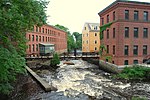Monan Park
2016 establishments in MassachusettsBaseball venues in BostonCatholic Conference (MIAA)College baseball venues in the United StatesColumbia Point, Boston ... and 3 more
High school baseball venues in the United StatesSports venues completed in 2016UMass–Boston Beacons baseball
Monan Park is a 500-seat baseball stadium located in Boston, Massachusetts, on Columbia Point. Monan Park is jointly owned by Boston College High School and the University of Massachusetts Boston. When it opened in the spring of 2016, it immediately became the home of both schools' baseball programs. Monan Park features the same outfield dimensions as Fenway Park and features a similar Green Monster in left-field. The Boston College High School Eagles are members of the Catholic Conference and compete at the Division 1 level of the MIAA. The UMass Boston Beacons are members of the Little East Conference of the NCAA Division III.
Excerpt from the Wikipedia article Monan Park (License: CC BY-SA 3.0, Authors).Monan Park
Bianculli Boulevard, Boston Dorchester
Geographical coordinates (GPS) Address Phone number Website Nearby Places Show on map
Geographical coordinates (GPS)
| Latitude | Longitude |
|---|---|
| N 42.315854 ° | E -71.042351 ° |
Address
Boston College High School
Bianculli Boulevard 150
02125 Boston, Dorchester
Massachusetts, United States
Open on Google Maps








